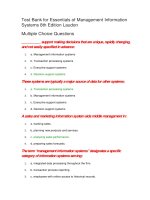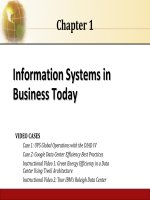Management information systems 13th laudon chapter 11
Bạn đang xem bản rút gọn của tài liệu. Xem và tải ngay bản đầy đủ của tài liệu tại đây (1.19 MB, 49 trang )
Chapter 11
Managing Knowledge
VIDEO CASES
Video Case 1: How IBM’s Watson Became a Jeopardy Champion.
Video Case 2: Tour: Alfresco: Open Source Document Management System
Video Case 3: L'Oréal: Knowledge Management Using Microsoft SharePoint
6.1
Copyright © 2014 Pearson Education, Inc. publishing as Prentice
Management Information Systems
Chapter 11: Managing Knowledge
Learning Objectives
• Describe the role of knowledge management and
knowledge management programs in business.
• Describe the types of systems used for enterprisewide knowledge management and how they
provide value for businesses.
• Describe the major types of knowledge work
systems and how they provide value for firms.
• Describe the business benefits of using intelligent
techniques for knowledge management.
11.2
Copyright © 2014 Pearson Education, Inc.
Management Information Systems
Chapter 11: Managing Knowledge
Designing Drugs Virtually
• Problem: Ineffective and complicated drug
discovery process
• Solutions: Use structure-based design to look for
molecules that may prove to be effective in fighting
disease.
• Demonstrates IT’s role in creating and sharing
knowledge to improve business efficiency
• Illustrates how information systems can increase
productivity and sales as well as help cure disease
11.3
Copyright © 2014 Pearson Education, Inc.
Management Information Systems
Chapter 11: Managing Knowledge
The Knowledge Management Landscape
• Knowledge management systems among fastest
growing areas of software investment
• Information economy
– 37% U.S. labor force: knowledge and information workers
– 45% U.S. GDP from knowledge and information sectors
• Substantial part of a firm’s stock market value is
related to intangible assets: knowledge, brands,
reputations, and unique business processes
• Well-executed knowledge-based projects can
produce extraordinary ROI
11.4
Copyright © 2014 Pearson Education, Inc.
Management Information Systems
Chapter 11: Managing Knowledge
The Knowledge Management Landscape
• Important dimensions of knowledge
– Knowledge is a firm asset.
• Intangible
• Creation of knowledge from data, information, requires
organizational resources
• As it is shared, experiences network effects
– Knowledge has different forms.
• May be explicit (documented) or tacit (residing in
minds)
• Know-how, craft, skill
• How to follow procedure
• Knowing why things happen (causality)
11.5
Copyright © 2014 Pearson Education, Inc.
Management Information Systems
Chapter 11: Managing Knowledge
The Knowledge Management Landscape
• Important dimensions of knowledge (cont.)
– Knowledge has a location.
• Cognitive event
• Both social and individual
• “Sticky” (hard to move), situated (enmeshed in firm’s
culture), contextual (works only in certain situations)
– Knowledge is situational.
• Conditional: Knowing when to apply procedure
• Contextual: Knowing circumstances to use certain tool
11.6
Copyright © 2014 Pearson Education, Inc.
Management Information Systems
Chapter 11: Managing Knowledge
The Knowledge Management Landscape
• To transform information into knowledge, firm must expend
additional resources to discover patterns, rules, and contexts
where knowledge works
• Wisdom:
– Collective and individual experience of applying knowledge to solve
problems
– Involves where, when, and how to apply knowledge
• Knowing how to do things effectively and efficiently in ways
others cannot duplicate is prime source of profit and
competitive advantage
– For example, Having a unique build-to-order production system
11.7
Copyright © 2014 Pearson Education, Inc.
Management Information Systems
Chapter 11: Managing Knowledge
The Knowledge Management Landscape
• Organizational learning
– Process in which organizations learn
• Gain experience through collection of
data, measurement, trial and error, and
feedback
• Adjust behavior to reflect experience
– Create new business processes
– Change patterns of management decision
making
11.8
Copyright © 2014 Pearson Education, Inc.
Management Information Systems
Chapter 11: Managing Knowledge
The Knowledge Management Landscape
• Knowledge management
– Set of business processes developed in an
organization to create, store, transfer, and apply
knowledge
• Knowledge management value chain:
– Each stage adds value to raw data and information as
they are transformed into usable knowledge
– Knowledge acquisition
– Knowledge storage
– Knowledge dissemination
– Knowledge application
11.9
Copyright © 2014 Pearson Education, Inc.
Management Information Systems
Chapter 11: Managing Knowledge
The Knowledge Management Landscape
• Knowledge management value chain
1. Knowledge acquisition
• Documenting tacit and explicit knowledge
– Storing documents, reports, presentations, best
practices
– Unstructured documents (e.g., e-mails)
– Developing online expert networks
• Creating knowledge
• Tracking data from TPS and external sources
11.10
Copyright © 2014 Pearson Education, Inc.
Management Information Systems
Chapter 11: Managing Knowledge
The Knowledge Management Landscape
• Knowledge management value chain (cont.)
2. Knowledge storage
• Databases
• Document management systems
• Role of management:
– Support development of planned knowledge storage systems.
– Encourage development of corporate-wide schemas for
indexing documents.
– Reward employees for taking time to update and store
documents properly.
11.11
Copyright © 2014 Pearson Education, Inc.
Management Information Systems
Chapter 11: Managing Knowledge
The Knowledge Management Landscape
• Knowledge management value chain (cont.)
3. Knowledge dissemination
• Portals, wikis
• E-mail, instant messaging
• Search engines
• Collaboration tools
• A deluge of information?
– Training programs, informal networks, and shared
management experience help managers focus
attention on important information.
11.12
Copyright © 2014 Pearson Education, Inc.
Management Information Systems
Chapter 11: Managing Knowledge
The Knowledge Management Landscape
• Knowledge management value chain (cont.)
4. Knowledge application
• To provide return on investment,
organizational knowledge must become
systematic part of management decision
making and become situated in decisionsupport systems.
– New business practices
– New products and services
– New markets
11.13
Copyright © 2014 Pearson Education, Inc.
Management Information Systems
Chapter 11: Managing Knowledge
The Knowledge Management Value Chain
FIGURE 11-1
11.14
Knowledge management today involves both information systems activities and a host of enabling
management and organizational activities.
Copyright © 2014 Pearson Education, Inc.
Management Information Systems
Chapter 11: Managing Knowledge
The Knowledge Management Landscape
• Organizational roles and responsibilities
– Chief knowledge officer executives
– Dedicated staff / knowledge managers
– Communities of practice (COPs)
• Informal social networks of professionals and
employees within and outside firm who have similar
work-related activities and interests
• Activities include education, online newsletters, sharing
experiences and techniques
• Facilitate reuse of knowledge, discussion
• Reduce learning curves of new employees
11.15
Copyright © 2014 Pearson Education, Inc.
Management Information Systems
Chapter 11: Managing Knowledge
The Knowledge Management Landscape
• Three major types of knowledge management
systems:
1. Enterprise-wide knowledge management systems
• General-purpose firm-wide efforts to collect, store, distribute, and
apply digital content and knowledge
1. Knowledge work systems (KWS)
• Specialized systems built for engineers, scientists, other
knowledge workers charged with discovering and creating new
knowledge
1. Intelligent techniques
• Diverse group of techniques such as data mining used for various
goals: discovering knowledge, distilling knowledge, discovering
optimal solutions
11.16
Copyright © 2014 Pearson Education, Inc.
Management Information Systems
Chapter 11: Managing Knowledge
MAJOR TYPES OF KNOWLEDGE MANAGEMENT SYSTEMS
FIGURE 11-2
11.17
There are three major categories of knowledge management systems, and each can be broken down further into
more specialized types of knowledge management systems.
Copyright © 2014 Pearson Education, Inc.
Management Information Systems
Chapter 11: Managing Knowledge
Enterprise-Wide Knowledge Management Systems
• Three major types of knowledge in enterprise
1. Structured documents
• Reports, presentations
• Formal rules
1. Semistructured documents
• E-mails, videos
1. Unstructured, tacit knowledge
• 80% of an organization’s business content is
semistructured or unstructured
11.18
Copyright © 2014 Pearson Education, Inc.
Management Information Systems
Chapter 11: Managing Knowledge
Enterprise-Wide Knowledge Management Systems
• Enterprise content management
systems
– Help capture, store, retrieve, distribute, preserve
• Documents, reports, best practices
• Semistructured knowledge (e-mails)
– Bring in external sources
• News feeds, research
– Tools for communication and collaboration
• Blogs, wikis, and so on
11.19
Copyright © 2014 Pearson Education, Inc.
Management Information Systems
Chapter 11: Managing Knowledge
Interactive Session: Organizations
Denver Goes Alfresco
Read the Interactive Session and discuss the following questions
• What types of problems was the consolidated city-county
government of Denver, Colorado, experiencing with document
management before instituting the Alfresco ECM system?
• How did the Alfresco ECM system provide a solution to these
problems?
• What management, organization, and technology issues had to be
addressed in selecting and implementing Denver’s new content
management system?
• How did the new content management system change
governmental processes for Denver? How did it benefit citizens?
11.20
Copyright © 2014 Pearson Education, Inc.
Management Information Systems
Chapter 11: Managing Knowledge
AN ENTERPRISE CONTENT MANAGEMENT SYSTEM
FIGURE 11-3
11.21
An enterprise content management system has
capabilities for classifying, organizing, and managing
structured and semistructured knowledge and making
it available throughout the enterprise.
Copyright © 2014 Pearson Education, Inc.
Management Information Systems
Chapter 11: Managing Knowledge
Enterprise-Wide Knowledge Management Systems
• Enterprise content management systems
– Key problem—Developing taxonomy
• Knowledge objects must be tagged with
categories for retrieval
– Digital asset management systems
• Specialized content management systems for
classifying, storing, managing unstructured
digital data
• Photographs, graphics, video, audio
11.22
Copyright © 2014 Pearson Education, Inc.
Management Information Systems
Chapter 11: Managing Knowledge
Enterprise-Wide Knowledge Management Systems
• Knowledge network systems
– Provide online directory of corporate experts in
well-defined knowledge domains
– Search tools enable employees to find
appropriate expert in a company
– Hivemine’s AskMe
– Includes repositories of expert-generated content
– Some knowledge networking capabilities included in
leading enterprise content management and
collaboration products
11.23
Copyright © 2014 Pearson Education, Inc.
Management Information Systems
Chapter 11: Managing Knowledge
Enterprise-Wide Knowledge Management Systems
• Collaboration and social tools
– Social bookmarking
• Sharing and tagging bookmarks
– Folksonomies
• User-created taxonomies for tagging
– Examples:
• Delicious
• Slashdot
11.24
Copyright © 2014 Pearson Education, Inc.
Management Information Systems
Chapter 11: Managing Knowledge
Enterprise-Wide Knowledge Management Systems
• Learning management systems (LMS)
– Provide tools for management, delivery, tracking,
and assessment of various types of employee
learning and training
– Support multiple modes of learning
• CD-ROM, Web-based classes, online forums, live
instruction, and so on
– Automates selection and administration of courses
– Assembles and delivers learning content
– Measures learning effectiveness
11.25
Copyright © 2014 Pearson Education, Inc.









